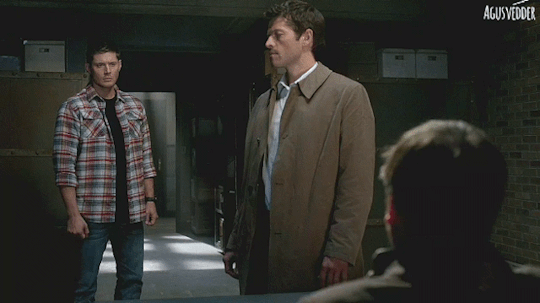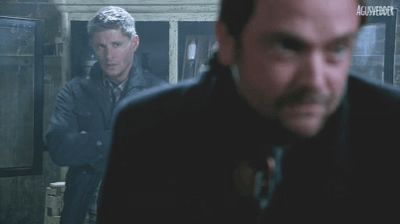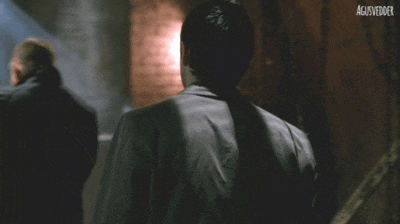#vol. XLIV
Explore tagged Tumblr posts
Text
Destiel Chronicles
Vol. XLIV
It was a love story from the very beginning.
Comfort Me
(9x10)
Hello my friends!!!! How are you? Happy New Year!
This is another meta from this series. This time I will dedicate the entire meta to episode 9x10 Road Trip, it was a very Destiel one, and we could see how Castiel was comforting Dean the whole time, it was so sweet and romantic.
I want to say thank you to my friend @agusvedder , she made the first for this meta and discussed with me the episode! Thank you girl!
Now, let's start...
You Are my Oasis
Okay, this sounds very romantic, because it is...
When Castiel went to see Dean, because he called him (!!!) at the beginning of episode 9x10 Road Trip, we knew he had to burn Kevin's body, he was tremendously sad, but when he saw Cas... He smiled and... He complimented him, he checked him out, he was really enjoying the sight of Castiel. Cas is Dean's Oasis in this episode, is Dean's comfort. He called him because he needed his help, and because he needed his friend. He needed someone to be there for him. So this episode showed us how Dean relayed on Cas, but not like friends... If you rewatch it, is like seeing one man comforting his boyfriend. Is the sensation that it left me while I was paying attention to the Destiel scenes.

So Dean talks with Cas ... Remember when they talked with honesty? 😭💔
Well, Dean is feeling too much guilt, and Cas is trying to shove that out from him. He is comforting Dean the whole time! He is saying the exact words Dean needs to hear.
And then...

Cas can't let Dean call himself stupid, he stands up to point his position, to remark to Dean his words. To have Dean security with it. And because he understands him... Cas felt he was a dumb too, when he thought he will save Heaven by trusting in Metatron, and that costed him his grace.
And because Cas is beautiful, inside and outside, is delightful for Dean, is his Oasis, is his comfort...
Talking with the eyes
Really, this episode is breathtaking. First we had Dean smiling, checking out his gorgeous angel even when he was so destroyed. And now...
While they were interrogating Crowley, they were looking at each other almost constantly, and is perfect, because, their crossed gazes, being so so close to each other, when Crowley was talking about Dean... About what torments Dean...
CASTIEL: Kevin is dead.
First topic that is carving in Dean's soul, the guilt of Kevin's dead is on the table now, and Crowley made a fest with it
CROWLEY: Oh. I'm sorry to hear that.
CASTIEL [harshly] Don't pretend you care. You tried to kill him.
CROWLEY: I told him this was gonna happen. I was the only person who tried to warn him. I told him to run.
Crowley is trying to drag the conversation to the fact that Dean is dangerous. Everyone who gets bear him, dies.
DEAN: From what?
CROWLEY: You. How many times am I gonna have to say this? People in your general vicinity don't have much in the way of a life-span.

When Crowley exposed Dean's fears and guilt, Castiel reached for his eyes, to comfort him, he is saying DON'T LISTEN TO HIM. LOOK AT ME, YOU ARE NOT THAT. YOU ARE NOT DANGEROUS. I KNOW.
This glare is so beautiful, is so comforting, Crowley is trying to hurt Dean and Cas is protecting him for that harm, with just one look, because they talk like this. With the eyes. And this is very very romantic.
CROWLEY: Now, I can't teach you how to crack open an angel. It's more... art than science. But I can do it for you. All I ask in return is a little field trip. Dying for some fresh air. Chains on, naturally.
DEAN: No.
CROWLEY: No? Of course not. Because if I'm plan "A," I'm sure you have a totally viable, much better plan "B."
CASTIEL [and DEAN pull aside] You can't be considering this.
DEAN: With the chains on, he can't do anything.
CASTIEL: It's Crowley. He can always do something.
CROWLEY: Looks like we need a tiebreaker. Go get Moose, squirrel. [DEAN's mask slips and you can see his guilt]

Unless... Unless, of course, you can't. That's why you're here, isn't it? The poor giant baby's in trouble again, isn't he?

Another Guilt exposition from Crowley: Sam, possessed by Gadreel, now are gone and that's a huge problem now. So...
Second exposition of guilt, and Cas is searching for his eyes again. Another comforting glare to Dean. WE WILL FIND HIM, WE HAVE A PLAN. EVERYTHING IS GONNA BE OKAY. SAM IS GONNA BE OKAY.
If this isn't romantic, I don't know what it is. Complicity and comfort on those gazes, so much love and understanding. Cas is there to be Dean's Oasis.
Comfort Me
It was very comic watching Cas and Crowley fighting like children, it was really a sit com right in front of our eyes.
And don't forget the fact that Cecily, the demon , mentioned angel Castiel was hot, and she called him too Capitan Sexy, like... Castiel's sex appeal is well known between angels and demons.
But let's focus now in that important scene when Crowley tried to get Gadreel's name in Sam's body.
Watching Sam's vessel suffering was too much for Dean, and he had to leave for a moment. If you recall that time when they had to lock Sam because he was having this demon drinking issue again, and Dean left, and Castiel saw him but he didn't follow him? Well, this time is totally different, because, Cas was the whole episode paying special attention to Dean, and when he saw he left, he followed him...


CASTIEL: Hey.
DEAN: I can't watch that anymore.
CASTIEL: I understand. It's not Sam, but... It's still Sam.
Castiel is comforting him again.

DEAN [voice cracking with emotion] Pretty much, yeah. How are you doing?
CASTIEL [kind of surprised] You want to talk about me now?
DEAN: I want to talk about anything that's not a demon sticking needles into my brother's brain.
[DEAN looks out a window trying to control his emotions but we see tears pooling in his eyes]
Yeah, humor me, man. How you doing?
CASTIEL: Uh... I'm okay.
Dean asks Castiel to distract him, maybe is something Cas didn't know how to send or how to response, so Dean shows him how.
DEAN: Good. Good. That's, uh... So, what, you just change the batteries out, power back up? It's that easy?
CASTIEL: It wasn't easy, but I didn't have a choice.
DEAN: Yeah. Well, that's usually how it goes.
Dean takes Castiel's quote to elaborate his apologies, because that time when he kicked Cas out from the bunker, it wasn't easy, but he thought he didn't have a choice. That's why he says THAT'S USUALLY HOW IT GOES.

DEAN: Cas... I'm sorry.
CASTIEL: About what?
DEAN: Kickin' you out of the bunker. That's, uh... You know, not telling you about Sam.
Remember when Dean could say I'm sorry to Cas?? Damn... But really... He couldn't even give a description to what was kicking Cas out from the bunker... Because it was horrible, and friends don't do that.
CASTIEL: You thought his life was at stake.
Castiel keeps comforting him, he doesn't want Dean feels more guilt.
DEAN: Yeah, I got played.
CASTIEL: I thought I was saving Heaven. I got played, too.

Cas is saying here SEE? I MADE MISTAKES TOO. DON'T BE SO HARD WITH YOURSELF.
This is perfect, how Cas steals another smile from Dean, how Cas comforts him again, all the time, trying to make Dean's weight less painfully to carry.
When they had to decide to enter inside Sam, Dean trusted in Castiel, but that wasn't possible and they had to let Crowley to go inside.
After this, and by the end of the episode, when Sam and Dean fought and they got separated, Cas watches Dean one more time, again comforting him...
To conclude:
Cas behaves in this episode like Dean's support, not just as a friend, because he does it with a dedication and a sweetness of a couple. Dean looks for that in him, and he finds it. The dedication and the support that Castiel gives him goes beyond a simple friendship, because there is intimacy and confidence in their eyes. Love and devotion.
I hope you enjoy this Chronicles, see you in the next ones!
Tagging @metafest @magnificent-winged-beast @emblue-sparks @weirddorkylittlediana @michyribeiro @whyjm @legendary-destiel @a-bit-of-influence @thatwitchydestielfan @misha-moose-dean-burger-lover @lykanyouko @evvvissticante @savannadarkbaby @dea-stiel @poorreputation @bre95611 @thewolfathedoor @charlottemanchmal @neii3n @deathswaywardson @followyourenergy @dean-is-bi-till-i-die @hekatelilith-blog @avidbkwrm @anarchiana @dickpuncher365 @vampyrosa @foxyroxe-art @authorsararayne @anonymoustitans @mybonsai1976 @love-neve-dies @wildligia @dustythewind @wayward-winchester67 @angelwithashotgunandtrenchcoat @trashblackrainbow @deeutdutdutdoh @destiel-is--endgame @destiel-shipper-11 @larrem88 @charmedbycastiel @ran-savant @little-crazy-misha-minion @samoosetheshipper
@shadows-and-padlocked-hearts @mishtho @dancingtuesdaymorning @nerditoutwithbooks @mikennacac73 @justmeand-myinsight @idontwantpeopletoknowmyname @tenshilover20 @teddybeardoctor @pepevons @helevetica @isthisdestiel @dizzypinwheel @jawnlockwinchester
If you want to be added or removed from this list, just let me know.
If you want to read my previous s9 metas here are the links...
Vol. XL, Vol. XLI, Vol. XLII, Vol. XLIII.
Buenos Aires, December 30th 2019 8:08 PM
168 notes
·
View notes
Text
BTS as Florida man headlines master post
The OP that inspired it all
Vol I Vol XXVI Vol LI Vol II Vol XXVII Vol LII Vol III Vol XXVIII Vol LIII Vol IV Vol XXIX Vol LIV Vol V Vol XXX Vol LV Vol VI Vol XXXI Vol LVI Vol VII Vol XXXII Vol LVII Vol VIII Vol XXXIII Vol LVIII Vol IX Vol XXXIV Vol LIX Vol X Vol XXXV Vol XI Vol XXXVI Vol XII Vol XXXVII Vol XIII Vol XXXVIII Vol XIV Vol XXXIX Vol XV Vol XL Vol XVI Vol XLI Vol XVII Vol XLII Vol XVIII Vol XLIII Vol XIX Vol XLIV Vol XX Vol XLV Vol XXI Vol XLVI Vol XXII Vol XLVII Vol XXIII Vol XLVIII Vol XXIV Vol XLIX Vol XXV Vol L
BTS as Florida man: A Christmas Special
Kim Namjoon as Florida man
BTS as Florida man: Wholesome edition
#bts as florida man#tfw you started with roman numerals thinking you weren't going to make that many posts and now here we are ;.;
274 notes
·
View notes
Text

- E lo princep respos al almirall: -Ques aço que vos volets que yo hi faça? que si fer yo puch , -volenters ho fare.- Yo , dix lalmirall , quem façats ades venir la filla del rey Manfre, germana de madona la regina Darago, que vos tenits en vostra preso aci el castell del Hou , ab aquelles dones e donzelles qui soes bi sien ; e quem façats lo castell e la vila Discle retre . - E lo princep respos , queu faria volenters. E tantost trames un seu cavaller en terra ab un leny armat, e amena madona la infanta , germana de madona la regina , ab quatre donzelles e dues dones viudes. E lalmirall reebe les ab gran goig e ab gran alegre , e ajenollas, e besa la ma a madona la infanta.
Ramon Muntaner, CRÓNICA CATALANA, p. 221
Beatrice was born (probably) in Palermo around 1260. She was the first child and only daughter of Manfredi I of Sicily and his second wife, the Epirote princess Helena Angelina Doukaina (“[…] et idem helenam despoti regis emathie filiam sibi matrimonialiter coppulavit, ex quibus nata fuit Beatrix.”, Bartholomaeus de Neocastro, Historia Sicula, in Giuseppe Del Re, Cronisti e Scrittori sincroni Napoletani editi ed inediti, p. 419). It’s quite plausible the baby had been named after Manfredi’s first wife, Beatrice of Savoy (mother of Costanza, who will later become Queen consort of Aragon and co-regnant of Sicily). The little princess would soon be followed by three brothers: Enrico, Federico and Enzo (also called Anselmo or Azzolino). With three sons, Manfredi must have thought his succession was secured.
Beatrice’s father was one Federico II of Sicily’s many illegitimate children, although born from his most beloved mistress (and possibly fourth and last wife), Bianca Lancia. Since his father’s death in 1250, Manfredi had governed the Kingdom of Sicily on behalf firstly of his (legitimate) half-brother Corrado and, after his death in 1254, of Corrado’s son, Corradino. In 1258, two years prior Beatrice’s birth, Manfredi had been crowned King of Sicily in Palermo’s Cathedral, de facto usurping his half-nephew’s rights.
Like it had happened with Federico, Manfredi was soon opposed by the Papacy, which didn’t approve of the Hohenstaufen’s rule over Sicily (and Southern Italy with it) and the role of the King as the champion of the Ghibellines faction. In 1263, Urban VI managed to convince Charles of Anjou, younger brother of Louis IX the Saint, to present himself as a contender to the Sicilian throne. Three years later, on January 6th 1266, the French duke was crowned King of Sicily by the Pope in Rome, thus overthrowing Manfredi. On February 26th, in Benevento, the usurped King then tried to get back his kingdom by facing Charles in the open field, but failed and lost his life while fighting.
The now widowed Queen Helena had previously fled to Lucera (in Apulia) with her children (Beatrice was now six), her sister-in-law Costanza, and her step-daughter, the illegitimate Flordelis, where she thought they would be safer. When they got news of the disaster of Benevento and Manfredi’s death, they fled to Trani from where they planned to set off to Epirus. The unfortunate party was instead betrayed and handed off to the Angevin. On March 6th night, Helena and the children were taken hostage and later separated. The Queen was sent at first to Lagopesole (in Basilicata) and finally to Nocera Christianorum (now Nocera Inferiore), where she would die still in captivity in 1271.
Enrico, Federico and Enzo were taken to Castel del Monte. Following Corradino’s death in 1268, Manfredi’s young sons (the oldest, Enrico, was just four at the time of his capture) were, to all effects, the rightful heirs to the Sicilian throne. It’s undoubtful Charles must have wanted them gone, or at least forgotten. In 1300 they were moved to Naples, in Castel dell’Ovo (which, at that time, was called San Salvatore a mare), under the order of the new Angevin king, Charles II. According to some sources, Federico and Enzo died there within the short span of a year. As for Enrico, he died alone and miserable in October 1318, he was 56.
As for Beatrice, her fate was more merciful compared to that of her mother and brothers and, for that, she had to thank her sex, which made her harmless in Charles’ eyes (as long as she was left unmarried). After being separated from her family (she will never see them again), the six years old princess was, like her brothers, held captive (although not together) in Castel del Monte. In 1271, she was moved to Naples, in Castel dell’Ovo, under the guardianship of its keeper, a French nobleman called either Landolfo or Radolfo Ytolant. Manfredi’s daughter is mentioned in a rescript of Charles dated March 5th 1272, from which we learn she had been granted at least a maid (“V Marcii xv indictionis. Neapoli. Scriptum est Iustitiario et erario Terre laboris etc. Cum ex computo facto per magistrum rationalem Nicolaum Buccellum etc. cum Landulfo milite castellano castri nostri Salvatoris ad mare de Neapoli pro expensis filie quondam Manfridi Principis Tarentini et damicelle sue. ac filie quondam comitis Iordani et damicelle sue dicto castellano in unc. auri novem et taren. sex de pecunia presentis generalis subventionis residuorum quolibet vel qua canque alia etc. persolvatis. non obstante etc. Recepturus etc.”, Monumenti n. XLIV. in Domenico Forges Davanzati, Dissertazione sulla seconda moglie del re Manfredi e su’ loro figliuoli, p. XLIII-XLIV). Like it had happened with her mother, and unlike her brothers, it appears Beatrice was treated with courtesy and respect. In her misfortune, she could count on the company of a fellow prisoner and distant relative, the daughter of Giordano Lancia d’Agliano, who was her grandmother Bianca Lancia’s cousin and had been a loyal supporter of her father, Manfredi.
On Easter Day of 1282, an anti-Angevin rebellion sparkled in Palermo would soon transform itself into a war to get rid of the so much hated Frenchmen, the so-called War of the Sicilian Vespers. It’s dubious that, close in her prison, Beatrice came to know about it. She might have also been surprised to know that her half-sister, Costanza, had been asked by a delegation of fellow Sicilians to take possession of what was hers by right (the throne) as she was their “naturalis domina”. Her rights were shared with her husband, Pedro III of Aragon, who would personally take part in the war and be rewarded with a joint coronation in November 1282.
For Beatrice, everything changed in 1284. On June 4th, Italian Admiral Ruggero di Lauria, at the service of the Aragonese King (he was also Costanza’s milk brother), defeated the Angevin fleet just offshore from Naples and took Carlo II prisoner. Being in clear superiority, the Sicilians could now demand (among many requests) the release of Princess Beatrice. Carlo’s eldest son and heir, Carlo Martello Prince of Salerno, could nothing other than obliging them. (“Siciliani autem , & omnes faventes Petro Aragonum, incontinenti de ipsorum victoria plurimum exultantes, Nuncios, & Legatos ad quoddam Castrum ex parte Principis direxerunt , ubi quaedam filia quondam Domini Regis Manfredi sub custodia tenebatur , ut dicta filia fine ullo remedio laxaretur , quae statim fuit antedictis Legatis , & Nunciis restituta.”, Anonimo Regiense, Memoriale Potestatum Regiensium. Gestorumque iis Temporibus. Ab anno 1154 usque ad Annum 1290, in Ludovico Antonio Muratori, Rerum Italicarum scriptores ab anno aerae christianae quingentesimo ad millesimumquingentesimum, vol. VIII, p. 1158).
Beatrice, finally free, left Castel dell’Ovo headed for Capri, where the Admiral was waiting for her. She had spent 18 long years in captivity and was now 24. From Capri she reached Sicily, where she was warmly welcomed and with a lot of enthusiasm, to meet her half-sister Costanza.
As the Queen’s closest free relative (both Pedro and Costanza had no interest in asking for Enrico’s release since, as a male, he had more rights than Costanza to inherit the throne), Beatrice had a great political value. At first, Ranieri Della Gherardesca’s name came up. He was the son of that Count Gherardo who had fought together with the unfortunate Corradino (the sisters’ royal cousin), and for that had been beheaded in Naples in 1268 alongside his liege. Finally the perfect candidate was found. Manfredo of Saluzzo was born in 1262 and was the son of Marquis Tommaso I and his wife Luigia of Ceva. Like Beatrice, Manfredo was strongly related to Costanza, specifically, he was her nephew since Tommaso and the Sicilian Queen were half-siblings (they were both Beatrice of Savoy’s children).
The marriage contract between the two is dated July 3rd 1286 and the contracting parties are on one side “la serenissima signora constanza regina dy aragon e dy sicilia e dil ducato de puglia principato di capua” and, on the other side “il marchexe thomas di sa lucio signore de conio una cum mạdona alexia soa moglie”. Tommaso declares that Manfredi will inherit his title, privileges and possession upon his death. If, after the marriage is celebrated, Manfredi were to die first, Beatrice would enjoy possession of the castle and some properties. The Marquise Luisa declares to agree with her husband’s decision (“[…] e a tuto questo la marchexa aloysia madre dy manfredo consenty”, Gioffredo Della Chiesa, Cronaca di Saluzzo, p. 165-166). The union was formally celebrated the year after.
Beatrice bore Manfredi two children: Caterina and Federico, born presumably in 1287 (“Et da questa beatrix haue uno figlolo chiamato fredericho et una figlola chiamata Kterina” Gioffredo Della Chiesa, Cronaca di Saluzzo, p. 185). In 1296 Tommaso died, so Manfredi inherited the marquisate and Beatrice became Marquise consort of Saluzzo. She will die eleven years later at 47, on November 19th 1307 (“Venne a morte nel dì 19 novembre di quest’anno Beatrice di Sicilia moglie del nostro marchese Manfredo, e noi ne accertiamo il segnato giorno col mezzo del rituale del monastero di Revello , nel quale leggesi annotato: 19 novembris anniversarium d. Beatricis filiae quondam d. Manfredi regis Ceciliae et uxoris d. Manfredi primogeniti d. Thomae marchionis Saluciarum, quae huic monasterio quingen- tas untias in suo testamento legavit.” Delfino Muletti, Memorie storico-diplomatiche appartenenti alla città ed ai marchesi di Saluzzo, vol III, p. 76). Her husband would quickly remarry with Isabella Doria, daughter of Genoese patricians Bernabò Doria and Eleonora Fieschi. Isabella would give birth to five more children: Manfredi, Bonifacio, Teodoro, Violante and Eleonora.
As of Beatrice’s children, Caterina would marry Guglielmo Enganna, Lord of Barge (“Catherina figlola dy manfredo e de la prima moglie fu sorella dy padre e dy madre dy fede rico e fu moglie duno missere gulielmo ingana capo dy parte gebellina in questy cartiery dil pie monty verso bargie.”, Gioffredo Della Chiesa, Cronaca di Saluzzo, p. 256). Federico’s fate would be more complicated. Like many mothers before and after her, Isabella Doria wished to see her own firstborn, Manfredi, succeeded his father rather than her step-son. The new Marchioness of Saluzzo successfully instigated her husband against his son to the point the Marquis. in a donatio mortis causa dated 1325, disinherited Federico in favour of the second son (Federico would have settled with just his late mother’s belongings), Manfredi (“Et questo faceua a instigatione de la moglie che lo infestaua a cossi fare.” Gioffredo Della Chiesa, Cronaca di Saluzzo, p. 224). Federico’s natural rights were later acknowledged by an arbitral award proclaimed in 1329 by his paternal uncles Giovanni and Giorgio of Saluzzo, and finally, an arbitration verdict dated 1334 and issued by Guglielmo Earl of Biandrate and Aimone of Savoy. As a condition of peace, the future Marquis should have granted his younger brother the castle and villa of Cardè as a fief. Stung by this defeat, Manfredi IV, his wife Isabella and beloved son Manfredi retired to Cortemilla. Federico died in 1336 and was succeeded by his son Tommaso, who would inherit his father’s rights and feud with the two Manfredi's. After being defeated by his half-uncle in 1341 (the older Manfredi, his grandfather, had died the year before), resulting in losing his titles, possessions and freedom, Tommaso would later regain what was of his right and rule as Marquis of Saluzzo.
Sources
-ANONIMO REGIENSE, Memoriale Potestatum Regiensium. Gestorumque iis Temporibus. Ab anno 1154 usque ad Annum 1290, in Ludovico Antonio Muratori, Rerum Italicarum scriptores ab anno aerae christianae quingentesimo ad millesimumquingentesimum, vol. VIII
-BARTHOLOMAEUS DE NEOCASTRO, Historia Sicula, in Giuseppe Del Re, Cronisti e Scrittori sincroni Napoletani editi ed inediti
- DEL GIUDICE GIUSEPPE, La famiglia di Re Manfredi
- DELLA CHIESA, GIOFFREDO, Cronaca di Saluzzo
-FORGES DAVANZATI, DOMENICO, Dissertazione sulla seconda moglie del re Manfredi e su’ loro figliuoli
- LANCIA, MANFREDI, Il complicato matrimonio di Beatrice di Sicilia
-Monferrato. Saluzzo
-MULETTI, DELFINO, Memorie storico-diplomatiche appartenenti alla città ed ai marchesi di Saluzzo, vol II-III
- MUNTANER, RAMON, Crónica catalana
- SABA MALASPINA, Rerum Sicularum
- SAVIO, CARLO FEDELE, Cardè. Cenni storici (1207-1922)
-Sicily/Naples: Counts & Kings
#women#history#women in history#historical women#history of women#beatrice of sicily#manfredi i#helena angelina doukaina#costanza ii#manfredi iv of saluzzo#federico of saluzzo#caterina of saluzzo#House of Hohenstaufen#norman swabian sicily#aragonese-spanish sicily#house of saluzzo#people of sicily#women of sicily#myedit#historyedit
48 notes
·
View notes
Text
Lupercalia pt 3.

Chthonic, Apotropaic, Purification, and Fertility
Let us continue with Lycaeus. Classical Greek religion, as it was with the Italian Ligurians, was a blend of the cults of the indigenous peoples inhabiting the Aegean Sea (the Pelasgians) and Aryan settlers during the Bronze Age.
The Pelasgians were agrarian, buried their dead, and exhibited a belief in the afterlife. They had an earth mother as a supreme object of worship, similar to the Rhea or Cybele. She personified the life giving qualities of the earth, rain, crops, and fertility, but was also fearsome: she inflicted disease, attacked herds with predatory beasts, or unleashed the buried dead. As the Pelasgians were a settled people Her worship was highly localized. Figures of men in animal skins found on gems or seals are interpreted to be her priests, honoring her by wearing the pelts of sacred animals.
Homage was paid to her in the form of fertility rites to secure the rains and good harvest. If She withheld her boons her devotees would turn to rites of purification to rid themselves of the offending human sin. This would involve human sacrifice, as seen in archaeological evidence and in fables such as the Minotaur. This chthonic religion is uniquely non-Hellenic, bearing no resemblance to primitive Aryan religion.[x]
The Aryans were nomadic in lifestyle, their dead were cremated, their gods were anthropomorphic and traveled with them. This is reflected in the Homeric Poems: indifference to chthonic deities, the use of funeral pyres, no tombs or cults for the worship of heroes, and no dread of ghosts or demons. They worshiped variations of a supreme sky god or All-Father. In time, the integration of the Aryans into the Mediterranean displaced goddess worship, subordinating Her to he who would become Zeus.
The Aryans, finding themselves settling down in a new land among established peoples integrated the gods they found there rather than risk either divine or political wrath (a strategy that persists into the Roman Empire). And so the Pelasgian chthonic deities did not fully disappear but rather changed form to the rites of Brauronian Artemis, the Elysian Mysteries, and (more relevant to us) human sacrifice to Zeus Lycaeus. Those regions with the least Aryan transfusion - Attica, Arcadia, Crete, Boetia, and Lycia - had the strongest presence of chthonic cults. As we have seen the pattern of deity displacement and absorption with Aryan immigration, we might conclude whenever worship is localized to a tree, natural structure, or a place there is a strong probability that the root of the worship is pre-Aryan.
Lycaeus
In Arcadia the most venerated cult belonged to the god Varro and Isidorus named Lycaeus, meaning wolf. The seat of the cult was Mount Lycaeus, its capitol Lycaon (reputedly the oldest city in Greece). Lycaeus was a destructive, chthonic god, a protector of animals, and sender of rain. He was the embodiment of the prowling danger. His shrine was something of a wildlife refuge as no men were allowed to set foot there for fear of death.
Every nine years the festival of Lycaea or Lykaia (the prototype of the Lupercalia) was held. Sacrifices were expiatory; made to appease Lyceaus and keep him from preying upon the people and their flocks. Pausanias relates the practice of human sacrifice with the sacrificial blood sprinkled on the altar and the entrails given to the priest as sacrament. It was believed those who ate of the sacrificial victim would be transformed into wolves and sent into exile until the following festival.
Frazer (the Golden Bough, iv, 83) suggests that these priests may have disguised themselves in wolf pelts to perform the rites. If so, this echoes the worship of the Pelasgian Goddess and the numerous animal disguises depicted on Cretan seals. Similarly to the tale of Valeria Luperca, the legend of the king Lycaon being transformed into a wolf by Zeus may function as an analogy for the disgust the Hellenes held for human sacrifice, their (somewhat unsuccessful) attempt to stamp out the old ways, and the installation of their own All Father. Thus Lycaeus became an adjective for Zeus Lycaeus.
As we will see in the next post this subhumation did not quite fit Zeus, and fell to another god: Pan.
<< Pt. 1
<< Pt. 2
>> Pt. 4
Further Reading
Evans, A.(1901). The Mycenaean tree and pillar cult, and its Mediterranean relations (vol. XXI, pp. 99‑204). New York, NY: London: MacMillan. Retrieved from https://archive.org/details/mycenaeantreepil00evanuoft/page/98/mode/2up
Franklin, A. M. (1921) Lupercalia: rites and mysteries of wolf worship. Retrieved from http://penelope.uchicago.edu/Thayer/E/Roman/Texts/secondary/FRALUP/home.html
Hawes, C. H. And Hawes, H. B. (1922). Crete, the Forerunner of Greece (pp. 139‑43). New York, NY: Harper & Brothers. Retrieved from https://books.google.com/books/about/Crete_the_Forerunner_of_Greece.html?id=AxQOAQAAIAAJ&printsec=frontcover&source=kp_read_button
Hogarth, D.E. (1908). Aegean Religion. In Hastings, Selbie, Gray (Eds.), Encyclopaedia of religion and ethics (Vol. 1, pp. 141‑148). Toronto, Canada: Edinburgh : T. & T. Clark. Retrieved from https://archive.org/details/encyclopaediaofr01hastuoft/page/140/mode/2up
Lutfullina, V. Wolf Strider, edited. Retrieved from https://arcusxx.tumblr.com/post/155457634588 via Pinterest
Mackenzie, D. A. (1937) Myths Of Crete And Pre Hellenic Europe (pp. xliv‑xlvii, 59‑60, 159‑62, 293‑312). London, England: Gresham Publishing Co. Ltd. Retrieved from https://books.google.com/books/about/Myths_of_Crete_and_Pre_Hellenic_Europe.html?id=7hIaAAAAMAAJ&printsec=frontcover&source=kp_read_button
Tsountas, C. and Manatt, J. I. (1897). The Mycenaean Age: A study of the Monuments and Culture of Pre-Homeric Greece (pp. 294‑302). New York, NY: Houghton, Mifflin and Company. Retrieved from https://books.google.com/books/about/The_Mycenaean_Age.html?id=rO3OAAAAMAAJ&printsec=frontcover&source=kp_read_button
#lupercalia#luperca#she wolf#hellenistic pagan#hellenistic witch#hellenic pagan#hellenic polytheism#hellenic witch#paganblr#goddess worship#mother goddess#greek mythology#feminist witch#hekatean witch#lycaeus#werewolf
44 notes
·
View notes
Photo

"Don't gain the world and lose your soul; wisdom is better than silver or gold." ~Bob Marley ✌🎧🎶 "Tempus Fugit (Time Flies) Suite: Vol. XLIV"🕰🗝🦋 Acrylic, Ink, Gold Leaf, Antique Clock & Watch Parts (springs, dials, bezels, hands, gears, cogs, etc) c.late 1800s to early 1900s, Antique Sheet Music c.1890s, Painted Feathers (Butterflies), Antique Skeleton Keys c.1800s, Glossy Epoxy Archival ArtResin Glaze (shines like glass), On Canvas, 24 x 30 x 4" *Available at Art On Duval, A Procaccini Gallery @artonduval www.kregkelley.com 👨🎨 #timeflies #tempusfugit #modernart #artlover #artcollector #artgallery #artfollower #clock #contemporaryartist #artistsofinstagram #artsy #keywestartist #clockart #gold #abstract #butterflyart #artist #time #creative #artist #collageartist #artoftheday #beautiful #golden #artlovers #interiordesign #artcollectors #butterfly #abstractexpressionist #instaart (at Art On Duval Key West, A Procaccini Gallery) https://www.instagram.com/p/CQtZ7XrMtEt/?utm_medium=tumblr
#timeflies#tempusfugit#modernart#artlover#artcollector#artgallery#artfollower#clock#contemporaryartist#artistsofinstagram#artsy#keywestartist#clockart#gold#abstract#butterflyart#artist#time#creative#collageartist#artoftheday#beautiful#golden#artlovers#interiordesign#artcollectors#butterfly#abstractexpressionist#instaart
0 notes
Photo

Cat in the Dark Vol. XLIV #catinthedark #cat #instacat (at Grand Royal Lagoon Cancun) https://www.instagram.com/p/CHobxhrBTOM/?igshid=14qf3o0lu3dfr
0 notes
Link
I just added this listing on Poshmark: The Delineator Fashion Magazine - 1894.
0 notes
Text
Pierre GASSENDI (1592-1655).

Opera omnia: in sex tomos divisa, edited by Henri-Louis Habert de Montmor [ca. 1600-1670].
Lyon: Laurent Anisson and Jean Baptiste Devenet, 1658. $20,000
6 volumes bound in 3 heavy folio volumes, 36 cm. Volume One: Books 1 and 2. [lvi] 752 [14] pp.; [viii] 860 [10] pp. Volume Two: Books 3 and 4. [xliv] 662 [2] pp.; [viii] 536 pp.; Volume Three: Books 5 and 6. [xiii] 740 [34] pp; [xii] 545 [3] pp. Engraved portrait; woodcut diagrams and tables. Titles in red and black, engraved portrait by Robert Nanteuil in Volume 1, numerous woodcut diagrams and tables, especially in Book 4. Text printed chiefly in double columns.
This set is bound in contemporary vellum with gilt arms of Johann Jodocus Schmidmair von Schwartzenbruck; library numbers inked out on spines, embossed stamp and ink deaccession stamps on titles. Vol. 5, leaf Dd4 margin torn and repaired, generally sound otherwise; bright pages firmly bound with wide, clean margins.
First collected edition of Gassendi’s works, including many texts first published here. Chief among these is his important Epicurean treatise on logic, physics, and ethics, the Syntagma philosophicum, which occupies the first two of these six volumes. It includes the correspondence with Brahe, Campanella, Queen Christina of Sweden, Descartes, Galileo, Grotius, Hevelius, Kepler, Kircher, Peiresc, Schickard, and other celebrated scientists of the day. Volumes 3 and 4 collect his scientific writings, most notably his important astronomical works. Volumes 5 and 6 present additional material relevant to the study of astronomy, including his lives of Brahe, Copernicus, Regiomontanus and other notables, and his correspondence with Brahe, Campanella, Queen Christina of Sweden, Descartes, Galileo, Grotius, Hevelius, Kepler, Kircher, Peiresc, Schickard, and other celebrated scientists of the day.
Born in Provence, Gassendi was one the leading lights of the scientific revolution. As Richard Popkin notes in his history of skepticism, Gassendi had “an extremely important intellectual career, whose development, perhaps more than that of René Descartes, indicates and illustrates … ‘the making of the modern mind.’” Introducing an atomism drawn from Epicurus into the mainstream of European thought, Gassendi offered an empiricist alternative to Aristotelianism and Cartesanism, and was the first to articulate the mind-body problem. Molière and Cyrano
de Bergerac numbered among his students; Newton, Boyle and Barrow were among those who expressed their debt to Gassendi. His argument with Descartes over ontology and epistemology represented one of the great intellectual feuds of the day, a battle between giants. Edward Gibbon praised Gassendi’s work by styling him “le meilleur philosophe des littérateurs, et le meilleur littérateur des philosophes.”
It is as an observational astronomer that Gassendi is best celebrated today. The large lunar crater Gassendi is named in his honor. He was the first person to describe the transit of a planet across the Sun. Kepler had predicted the event, but it was Gassendi who first observed it in 1631, with a telescopic apparatus borrowed from Galileo that projected images on a sheet of paper.

Besides his work on the transit of Mercury, volume Four of the Opera Omnia collects Gassendi’s general treatises on astronomy as well as his analyses of Copernicus and Brahe, and his careful observations of a wide range of phenomena, including eclipses, comets, lunar coronas, planetary distances and orbits, parhelia, and other celestial topics. The volumes also present Gassendi’s contributions to other realms of science, including his reports on measuring the speed of sound, the rotation of the earth, the creation of vacuum, and the principle of inertia. Recent scholarship has focused on Gassendi’s correspondence, collected in volume Six, as an important source for understanding intellectual networks during the scientific revolution.
This is a handsome example of a rare and important work, represented in only a handful of institutional collections (the vast majority of listings in OCLC are microforms or facsimile reprints). The gilt arms embossed on the cover are those of Johann Jodocus Schmidmair von Schwartzenbruck (1611-1647), but given his dates we think it more likely that the book was acquired by his wife, Anna-Maria or possibly his son, Johann Friedrich Schmidmair von Schwartzenbruck (1624–1669).
Turner & Gomez, Pierre Gassendi, 116; Carli & Favaro, Bibliographia Galileiana, 260; Houzeau & Lancaster, Bibliographie générale de l’astronomie 3404; Brunet Manuel du libraire, II : 1499; Krivatsky Catalogue of 17th Century Books, 4572

An Impressive Set of the Works of Gassendi Pierre GASSENDI (1592-1655). Opera omnia: in sex tomos divisa, edited by Henri-Louis Habert de Montmor .
0 notes
Text
Destiel Chronicles
Vol. L
It was a love story, from the very beginning.
Love Story (Part II)
(9x22b/9x23)
Hi my friends! How are you? We arrived to the last meta from season 9! I can't believe we are here! Okay okay... Getting emotional...
I want to say thank you to my dearest friend, @agusvedder , she made the gifs for this analysis!! 💕💕
Cas Will always choose Dean
When Metatron's trap for Castiel was settled, he confronted him in front of his soldiers.
HANNAH: Why would we follow you?
METATRON: Well, look around. You've seen earth. You've had a taste of free will. I got to ask you -- do you like it? I mean, the way you've flocked off to follow Castiel tells me you need to follow someone. It's in your DNA.
Metatron needs to discredit Castiel in front of his followers, he needs to cover with mud all the brightness Castiel was offering: Earth/Free Will/Their innate mission to protect Humans. That's why he wants to tear down the Castle in the air, presenting them the inevitability of their lore. They're condemned to follow. And this recalls me what Michael had said in season 5 FREE WILL IS AN ILLUSION. The huge lie to keep the angel quiet and obedient.
METATRON: (...) But Cas -- he's not what you think he is. He sends angels out to die. Have you told them about your stolen Grace, Castiel? How it's fading away, and when it burns out, so will you?
Several things in this part of the speech, first of all, here is the discredit of the Great Castiel, he is showing them one only truth, the stolen grace, because is the only thing Cas can't deny, because is real. He stole grace, and is burning. But that's not the focus, the focus are the bomber angels. Is very smart from Metatron to use one only truth to plant a huge lie. And he is successful with that.
METATRON: (...) So...No, then. I'm not the best, but I'm the best you've got. You want to stay with Castiel, fine, but he's playing you, because at the end of the day, the only thing he cares about is himself and the Hardy boys there. You've got a choice to make. Make the right one
Playing the role of victim, saying "I'm not the best", to drag the angel by his side, and then, saying Sam and Dean is the only two persons he cares about (knowing the angel's were experiencing how Cas was always by the Winchesters side), was the last stab. Cas is in troubles now.
Hannah took the leadership, and defied Castiel, making him choose between them and the Winchesters. But not Sam and Dean... They threatened jus DEAN, why? Because the angels knew Dean was Castiel's weakness.
HANNAH: You gave us order, Castiel, and we gave you our trust. Don't lose it over one man. [She hands a blade to CASTIEL] This is justice.

Hannah is determinant here, she is testing Cas' loyalty... And she lost, because Castiel will always choose Dean...

Revealing Castiel's weakness
While settling down the trap, Metatron discovered Castiel true weakness...

You would say HE IS IN LOVE WITH HUMANITY, is a call to each human, because Castiel loves humans, he always had said he loves his father's creations.
But Metatron will certified in the last episode what he was talking about with HUMANITY. We will see in my next point.
When they come back to the bunker, Cas is desolated because he thinks he had lost every opportunity to defeat Metatron.
But someone is happy there: Dean.
Dean was kind of jealous of Castiel being a Commander again, leading angels. He had always hated when Cas shows any hint of interest in coming back to Heaven with his brothers. So... He leading an entire army of angel? It wasn't a good sign to keep Cas safe and with him.

There was a hint of melancholy in this scene, like... Destiel in the old times... But the weight of Dean's words here... He acknowledged Cas had chosen him, because Castiel loves him. And because his loyalty to him is intact. And Cas asks again his fears... Does Dean still believe he was capable to use angels as bombs? Because that was the fear he had in his now very human heart. But with this proof of love, Dean has not doubts. Cas is back, and with him, just for him.
That's why he settles again TFW speech...

He did it in the same episode in which Michael said that nefarious quote about TFW, remember? With the ONE COMATOSE CASTIEL on the bed.
I see a huge connection between that episode in season 5, this season 9 entirely, and season 15 about TFW and God/Metatron trying to control the will.
But concluding Dean is Cas' weakness ( as we will see textually in episode 12x10 too).
Cas did everything because of Dean
In episode 9x23 we had the confirmation of what Metatron wanted to say when he concluded that Cas was in love with humanity.
NEIL: Is that the new Angel handbook you're working on, or, uh...?
METATRON: No, no, this is a story, Neil, a marvelous story, full of love and heartbreak and...love.
NEIL: Sort of like "The Notebook."
Okay, Metatron is writing a love and love story here ... He mentions a heartbroken... Basically, he is inspired by Castiel's feelings for Dean, because that's the big secret he had just discovered. So is a story of love... (Family love, humanity love) and love with a heartbroken and that's Destiel. Because of what Metatron is about to do: KILL DEAN WINCHESTER. That way, by killing Castiel's weakness, he will defeat him completely.
And is hilarious angel Neil talking about a very romantic movie The Netbook, talks about a true love between a girl and a young man from different social class. Practically, a Destiel mirror.
Jumping to the confrontation between Metatron and Castiel at the end of the episode... He face our angel with the Truth he had just revealed...


That's it there's HUMANITY for Metatron. That's the humanity he was talking when he mentioned Castiel's weakness... He is in love with Humanity -> you did everything to save just one human : DEAN.

The equation is complete.
And now that he talked about LOVE, Is time to talk about HEARTBROKEN...

He breaks Castiel's heart by revealing he is dead. The Love Story had come to it's end.
To Conclude:
Castiel's weakness is revealed in these two episodes. Cas will always choose Dean (and Sam) over any circumstances.
Metatron discovered Castiel deep and romantic love for Dean and decides to hit that spot, by writing a Greek tragedy. He recognized it was a love story, and he will try to break Castiel's heart by killing Humanity (Dean Winchester).
I hope you like this meta, ser you in season 10 next week! Yay!
Tagging @metafest @magnificent-winged-beast @emblue-sparks @weirddorkylittlediana @michyribeiro @whyjm @legendary-destiel @a-bit-of-influence @thatwitchydestielfan @misha-moose-dean-burger-lover @lykanyouko @evvvissticante @savannadarkbaby @dea-stiel @poorreputation @bre95611 @thewolfathedoor @charlottemanchmal @neii3n @deathswaywardson @followyourenergy @dean-is-bi-till-i-die @hekatelilith-blog @avidbkwrm @anarchiana @dickpuncher365 @vampyrosa @foxyroxe-art @authorsararayne @anonymoustitans @mybonsai1976 @love-neve-dies @wildligia @dustythewind @wayward-winchester67 @angelwithashotgunandtrenchcoat @trashblackrainbow @deeutdutdutdoh @destiel-is--endgame @destiel-shipper-11 @larrem88 @charmedbycastiel @ran-savant @little-crazy-misha-minion @samoosetheshipper
@shadows-and-padlocked-hearts @mishtho @dancingtuesdaymorning @nerditoutwithbooks @mikennacac73 @justmeand-myinsight @idontwantpeopletoknowmyname @tenshilover20 @teddybeardoctor @pepevons @helevetica @isthisdestiel @dizzypinwheel @jawnlockwinchester @horsez2 @qanelyytha @imjustkipping @shippsblog
If you want to be removed or added to this list, just let me know.
If you want to read the previous season 9 metas, Here are the links...
Vol. XL, XLI, XLII, XLIII, XLIV,
XLV, XLVI, XLVII, XVIII, XLIX
Buenos Aires February 26th 2020 4:18 PM
109 notes
·
View notes
Text
Presence Matters: The Drift, Vol. XLIV
Presence Matters: The Drift, Vol. XLIV



Navigation Brief
ALEXANDRIA – Good Afternoon, Drifters
Nostalgia is a hell of a drug. At the end of Adm. Jonathan Greenert’s tenure as Chief of Naval Operations, I have to admit I was relieved. Not because I thought he was a bad CNO or anything, but because as a journalist who was assigned to cover CNO, I got tired of hearing the same talking points repeatedly. And to be fair, I…
View On WordPress
0 notes
Text
CMP031 Face to Face with Death
The ashen face of Death turns his gaze upon our hero!
In the last episode, Pwyll had gone hunting in the Woods of Glyn Cuch and had been beaten to the kill by a stranger pack comprising even stranger dogs. Having decided that the kill was rightfully his, he had driven off the other pack and set his own dogs upon the prey. It was at that moment that a stranger, the Shadowed Hunter, has appeared and was even now turning his dread gaze upon Pwyll. We'd also like to introduce our Special Surprise Guest Actor, Damh the Bard, who plays an important role in this show!
This episode is the second episode in our Welsh Mythology series and continues with the story of Pwyll, the Prince of Dyfed.
Full Show-notes, with sources and credits, can be found on our main Website at http://celticmythpodshow.com/welsh2
Running Order:
Intro 0:41
News & Views 1:15
DigVentures on the Radio 3:05
Story 9:30
Listener Feedback - Sean 126:12
Promo - Druidcast 20:33
We hope you enjoy it!
Gary & Ruthie x x x
Released: 12 May 2012, 32m
We love to get your feedback, please email [email protected], or call us on Speakpipe
News & Views
We talk about the Flag Fen Rescue project, Flag Fen Lives, organised by DigVentures and the charity that manages Flag Fen, Vivacity. We also re-play the interview that Paul Stenton of BBC Camridgeshire's breakfast show had with Sarah Stannage of Vivacity and Lisa Westcott-Wilkins, the Managing Director of DigVentures.
Built by Bronze Age people as a place of worship and ritual, the causeway contains 60,000 upright timbers and 250,000 horizontal planks buried underground along with many swords and other personal 'offerings' to the watery fen. Now under threat of being lost to the elements, it is a matter of urgency to Rescue and research as much as possible within the remaining time. See how you can help the project and get involved on the DigVentures site.
Face to Face with Death: Part 2 of the First Branch and Part 2 of the Mabinogion
Names Used in this Story
Listed in order of appearance
Pwyll
Dyfed
Cuch
Glyn Cuch
Arawn
Annwn
Hafgan the Summer-White
"Storm"
Tylwyth Teg
Places mentioned in the Story
Episode 2 is also the second episode of the First Branch: Pwyll, Prince of Dyfed. The area of the Wales that Pwyll rules is called Dyfed, and at the estimated time of the writing of the First Branch (during the Medieval period). There is some debate as to the area of the original seven cantrefs, and Wiki provides us not only with a revised version but also names the seven areas. This is the area as it was known in the 7th Century and although the tales were not written down until the early medieval period, there is much evidence - linguistic and political - to suggest that the events recounted in the Mabingion, based on real events and/or mythology, took place at this time.
Click on the image to see it enlarged.
The actual journey that Pwyll makes in this episode is derived from clues given within the various translations and is, essentially, an educated guess! :) However, below you can see the path that Pwyll would have taken in traverlling from Arberth to Glyn Cuch.
Click on the image to see it enlarged.
The actual journey that Pwyll makes in this episode is derived from clues given within the various translations and is, essentially, an educated guess! :) However, below you can see the path that Pwyll would have taken in traverlling from Arberth to Glyn Cuch, and also from the map above that he would actually have been travelling from one Cantref to another in the journey.
Listener Feedback
Sean
We play some audio feedback from our friend Sean who runs the IRFT Celtic Radio show as often as he can. Thank you for your thoughts Sean and we wish you the best of luck with keeping your station on the air.
Promo - IRFT Celtic Music ... with a Twist
Sean
Music from the seven celtic nations, and the Americas. We play Folk-Rock radio and Rock radio. Sadly, Sean has had some problems keeping the show on the air but you can still visit his Myspace page and read his blogs. He has deliberately left the page as a tribute to the great musicians he has featured. IRFT Celtic Music ... with a Twist
Promo - Druidcast
Damh the Bard & O.B.O.D.
Druidcast
Your host is Damh the Bard and each episode he will feature poetry, story and song offered by Bards throughout the world. There will also be interviews with people from the Druid tradition, seasonal thoughts, explorations of Celtic mythology and history, reviews, and competitions.
You can hear the full podcasts at: http://www.druidcast.libsyn.com/ or subscribe through your podcatcher, or through iTunes.
Huge Thanks to our Guest Actors
Damh the Bard
We also would like to say a really big 'Thank you' to Damh the Bard for playing the part of Arawn in our Tale, and would like to remind you that you can find him and his wonderful music on his website or listen to him on Druidcast podcast.
Sources used in this Episode
The Mabinogion, pp ix-xxxvi, 3-21, 227-232, Sioned Davies , Oxford, 2007, ISBN 978-0-19-283242
The Mabinogion, pp 9-41, 45-65, Jeffrey Gantz, Penguin, 1976, ISBN 0-14-044322-3
The Mabinogion, pp ix-xliv, 3-24, 275-278, Gwyn Jones & Thomas Jones, Dent & Dutton, 1977, ISBN 0-460-01097-2. Can also be found online at www.donaldcorrell.com
Pwyll Pendeuc Dyfed, Lady Charlotte Guest, Mary Jones
Pwyll, Prince of Dyfed, Lady Charlotte Guest, 1877, Sacred Texts
Notes to Pwyll, Prince of Dyfed, Lady Charlotte Guest, 1877, Sacred Texts
The Mabinogion, Lady Charlotte Guest, 1849, Project Gutenberg
The Mabinogi of Pwyll, W. M. Parker, mabiongi.net. Notes at mabinogion.info
'The Lord of Dyfed', from Legends of the Celts, p.134ff, Frank Delaney, HarperCollins, 1991, ISBN 0-586-21151-9
Tales from the Mabinogion, Gwyn Thomas & Kevin Crossley-Holland, Gollancz, 1984, ISBN 0-575-03531-5
Celtic Myths & Legends, p.147ff, Michael Foss, Selectabook Ltd., 1998, ISBN 0-75252-402-X
Prince of Annwn, Evangeline Walton, Del Rey, 1974, ISBN 0-345-27060-6
Encyclopaedia of Celtic Wisdom, p.117, 156, Caitlin & John Matthews, Element, 1994, ISBN 1-85230-560-6
The Celts, p.211, Frank Delaney, Grafton, 1989, ISBN 0-586-20349-4
Women in Celtic Myth, Moyra Caldecott, Arrow, ISBN 0-09-955920-X
Celtic Heritage, p.41 ff, Alwyn & Brinley Rees, Thames & Hudson, 1978, ISBN 978-0500110089
Pagan Celtic Britain, p.288, Anne Ross, Constable, 1967, ISBN 0-09-472330-3
'Myth in the Mabiogion', from A Celtic Reader, p.151, John Matthews, Aquarian, ISBN 0-85030-935-2
Celtic Myths and Legends, p.356 ff, T. W. Rolleston, 1995, ISBN 978-1859580066
Celtic Folklore: Welsh & Manx Vol.2, pp 499ff, John Rhys, Wildwood House, 1980, ISBN 0-7045-0406-5
The White Goddess, p.215ff, Robert Graves, Faber, 1952
And, of course, the Awen - inspiration and imagination!
Special Thanks
For incidental music:
Seraphic Panoply, Tribesman from The Darkshore Collection. See the Contributor page for more details.
Silence, Cellule from his album L'autre endroit. See the Contributor page for more details.
Roger Subirana, Jugant amb les estrelles from his album L'indret prohibit and A piece of heaven from his album Point of No Return. See his Contributor page for more details.
DIY-Note, Un from their album Ruptures. See the Contributor page for more details.
Diane Arkenstone The Secret Garden. See the Contributor page for details.
Kim Robertson, Angels in Disguise, All or None . See the Contributor page for details.
Jigger Time Ticks Away. See the Contributor page for details.
For our Theme Music
The Skylark and Haghole, the brilliant Culann's Hounds. See their Contributor page for details.
Extra Special Thanks for Unrestricted Access to Wonderful Music
(in Alphabetic order)
Anne Roos Extra Special thanks go for permission to use any of her masterful music to Anne Roos. You can find out more about Anne on her website or on her Contributor page.
Caera Extra Special thanks go for permission to any of her evocative harping and Gaelic singing to Caera. You can find out more about Caera on her website or on her Contributor Page.
Celia Extra Special Thanks go for permission to use any of her wonderful music to Celia Farran. You can find out more about Celia on her website or on her Contributor Page.
Damh the Bard Extra Special thanks go to Damh the Bard for his permission to use any of his music on the Show. You can find out more about Damh (Dave) on his website or on his Contributor page.
The Dolmen Extra Special thanks also go to The Dolmen, for their permission to use any of their fantastic Celtic Folk/Rock music on the Show. You can find out more about The Dolmen on their website or on our Contributor page.
Keltoria Extra Special thanks go for permission to use any of their inspired music to Keltoria. You can find out more about Keltoria on their website or on their Contributor page.
Kevin Skinner Extra Special thanks go for permission to use any of his superb music to Kevin Skinner. You can find out more about Kevin on his website or on his Contributor page.
Phil Thornton Extra Special Thanks go for permission to use any of his astounding ambient music to the Sonic Sorcerer himself, Phil Thornton. You can find out more about Phil on his website or on his Contributor Page.
S.J. Tucker Extra Special thanks go to Sooj for her permission to use any of her superb music. You can find out more about Sooj on her website or on her Contributor page.
Spiral Dance Extra Special thanks go for permission to use Adrienne and the band to use any of their music in the show. You can find out more about Spiral Dance on their website or on their Contributor page.
Get EXTRA content in the Celtic Myth Podshow App for iOS, Android & Windows
Contact Us: You can leave us a message by using the Speakpipe Email us at: [email protected]. Facebook fan-page http://www.facebook.com/CelticMythPodshow, Twitter (@CelticMythShow) or Snapchat (@garyandruth), Pinterest (celticmythshow) or Instagram (celticmythshow)
Help Spread the Word: Please also consider leaving us a rating, a review and subscribing in iTunes or 'Liking' our Facebook page at http://www.facebook.com/CelticMythPodshow as it helps let people discover our show - thank you :)
If you've enjoyed the show, would you mind sharing it on Twitter please? Click here to post a tweet!
Ways to subscribe to the Celtic Myth Podshow:
Click here to subscribe via iTunes
Click here to subscribe via RSS
Click here to subscribe via Stitcher
Save
Check out this episode!
2 notes
·
View notes
Audio
#ED4 #IIWII #XLIV
1 note
·
View note
Photo

“The electron theory of metals.” The Popular science monthly. Vol. XLIV. 1894.
53 notes
·
View notes
Photo

"Don't gain the world and lose your soul; wisdom is better than silver or gold." ~Bob Marley ✌🎧🎶 "Tempus Fugit (Time Flies) Suite: Vol. XLIV"🕰🗝🦋 Acrylic, Ink, Gold Leaf, Antique Clock & Watch Parts (springs, dials, bezels, hands, gears, cogs, etc) c.late 1800s to early 1900s, Antique Sheet Music c.1890s, Painted Feathers (Butterflies), Antique Skeleton Keys c.1800s, Glossy Epoxy Archival ArtResin Glaze (shines like glass), On Canvas, 24 x 30 x 4" *Available at Art On Duval, A Procaccini Gallery @artonduval www.kregkelley.com 👨🎨 #timeflies #tempusfugit #modernart #artlover #artcollector #artgallery #artfollower #clock #contemporaryartist #artistsofinstagram #artsy #keywestartist #clockart #gold #abstract #butterflyart #artist #time #creative #artist #collageartist #artoftheday #beautiful #golden #artlovers #interiordesign #artcollectors #butterfly #abstractexpressionist #instaart (at Art On Duval Key West, A Procaccini Gallery) https://www.instagram.com/p/CQtZao9sRNt/?utm_medium=tumblr
#timeflies#tempusfugit#modernart#artlover#artcollector#artgallery#artfollower#clock#contemporaryartist#artistsofinstagram#artsy#keywestartist#clockart#gold#abstract#butterflyart#artist#time#creative#collageartist#artoftheday#beautiful#golden#artlovers#interiordesign#artcollectors#butterfly#abstractexpressionist#instaart
0 notes
Text
What does Hardy mean in this lemma?
I am concerned with the paper "Oscillating Dirichlet's Integrals" by G.H. Hardy (Quarterly Journal of Pure and Applied Mathematics, Vol. XLIV, pg 1-40). I don't understand Lemma 1, but I suppose this may be a problem of English comprehension?
First, some notation. Hardy defines (for positive functions) $f\prec g$ (and $g\succ f $) to mean that $g/f \to \infty $ (as $x\to 0$), $f \asymp g$ to mean that $f/g \in (\delta, \Delta)$ for some constants $0<\delta <\Delta$, $f\sim Ag$ to mean that $f/g\to A$ (for an unspecified constant $A$, that may change from line to line) and $f\sim g$ to mean that $f/g\to 1$ (the usual asymptotic notation).
Then he further states that he uses the symbols $\delta,\Delta$ to mean two different things (which cannot both occur at the same time): he writes $$ \log(1/x)^\Delta \prec (1/x)^\delta$$ to mean that the statement holds for any positive numbers $\Delta\gg1$ sufficiently large and $\delta \ll 1$ sufficiently small. At the same time, he would write $$ (1/x)^\delta \prec f \prec (1/x)^\Delta$$ to mean that there exists $\delta,\Delta>0$ such that this statement is true.
Now the lemma (Lemma 1). He has already made some assumptions on the functions so that it is always true for any $f,g$ under consideration that one of $f\prec g, f \succ g, f \sim Ag$ is true.
Lemma 1. If $f\succ 1, \phi \succ 1$, then either $f\succ \phi^\Delta$ or there is a number $a$ ($a\ge 0$) such that $f=\phi^a f_1$, where $\phi^{-\delta} \prec f_1 \prec \phi^{\delta}$. A similar result holds when $f\prec 1, \phi \prec 1$.
(Proof) For if it is not true that $f\succ \phi^\Delta$, we can find numbers $\alpha$ such that $$ f \prec \phi^\alpha$$ and we can divide the positive real numbers $\alpha,$ including zero, with at most one exception, into two classes such that for one class $f\succ \phi^\alpha$, and for the other $f\prec \phi^\alpha$. There is at most one number, viz. $a$, the number which divides the two classes, for which $f\sim A\phi^\alpha$. If $f\sim A \phi^a$, $a$ belongs to neither class. If, however $a$ belongs to one class or the other, and we put $f = \phi^a f_1$, it is clear that $\phi^{-\delta}\prec f_1 \prec \phi^{\delta}$. Thus the result of the lemma is true in either case.
Some notes -
"viz." means "namely"
It is written $\phi^{-\delta} f_1\prec \phi^\delta$ in the original lemma statement in the paper...surely this is wrong, and I have corrected it in the above.
I'm quite sure that I transcribed the $\alpha s$ and $a$s correctly, but I cannot say for sure due to the quality of my digital copy, which I include a clip of here if there is any doubt - https://i.stack.imgur.com/KWaUE.png.
Questions (at long last)
In the lemma statement, which interpretation of $\delta,\Delta$ is being used? I guess it is $f\succ g^\Delta$ for all $\Delta \gg 1$? and $\phi^{-\delta} \prec f_1 \prec \phi^{\delta}$ for $\delta \ll 1$? The other interpretation seems impossible when he also claims later that there are $\alpha $ such that $f \succ \phi^a$.
When he claims there is at most one $a$, is he implicitly saying also that the existence of $a$ is trivial and deserves no mention? I guess he would define $a$ as a supremum/infimum?
How does he claim that there is at most one $a$ such that $f\sim A \phi^a$, and then write "If $f\sim A\phi^a"$?
from Hot Weekly Questions - Mathematics Stack Exchange from Blogger https://ift.tt/33qQuvN
0 notes
Text
Acts of the Parliament of the Dominion of Canada, 1899
Page xliv: By Order in Council of the 3rd of August, 1898, the name of the customs port of entry known as Fort Cudahy, was changed and ordered to be hereafter known as the port of Dawson, in the Yukon Territory. ‘Vide Canada Gazette,’ vol. xxxii, p. 281.
Page xlviii: In the Province of British Columbia. The outport of Grand Forks to be detached from the survey of the port of New Westminster, and be erected into a port of entry and a warehousing port.
Page xlix: In the Province of Manitoba. The outport of Brandon to be detached from the survey of the port of Winnipeg and erected into a port of entry and a warehousing port.
Page lii: By Order in Council of the 17th of April, 1899, in virtue of the provisions of section 307 of the Inland Revenue Act, chapter 34 of the Revised Statutes, Sault Ste. Marie, in the province of Ontario, was declared to be a port of entry at which raw leaf tobacco may be imported into Canada. ‘Vide Canada Gazette,’ vol. xxxii., p. 2025.
……
By Order in Council of the 13th of June, 1899, in virtue of the provisions of section 307 of the Inland Revenue Act, chapter 34 of the Revised Statutes, Port Arthur, in the province of Ontario, was erected into a port of entry for raw leaf tobacco. ‘Vide Canada Gazette,’ vol. xxxii., p. 2470.
0 notes